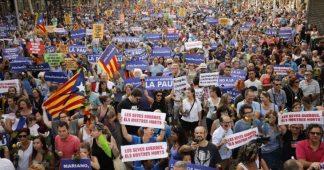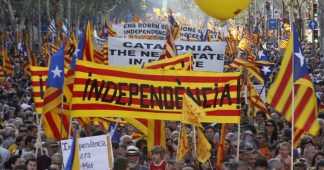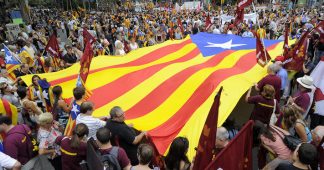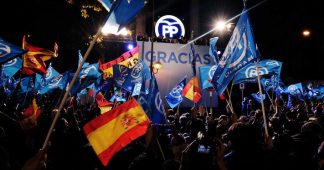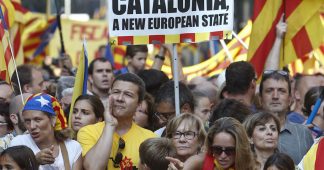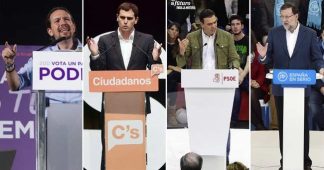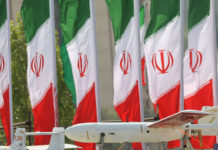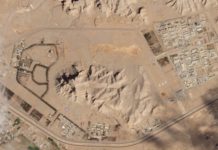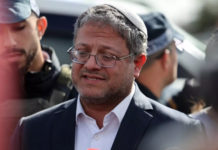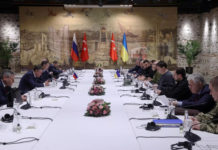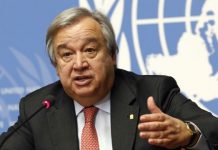Catalonia terror attacks: 500,000 march for tolerance as Spanish establishment blames independence movement
By Dick Nichols
September 4, 2017
After the August 17-18 terror attacks on Barcelona’s Rambla and in the seaside town of Cambrils, the half-million-strong march in the Catalan capital on August 26 expressed the profound desire in Catalan society to stay tolerant, open and un-militarised in the face of the terrorist threat. But it expressed more than that.
This was partly because the attacks — claimed by Islamic State and causing 16 deaths and up to 130 wounded — coincided with the tensest moments to date in the fight between the Catalan and Spanish governments over the planned October 1 referendum on Catalan independence.
The central People’s Party (PP) government of prime minister Mariano Rajoy is determined that a plebiscite that it claims is illegal will not take place: the pro-independence Catalan government of premier Carles Puigdemont, basing itself on the 70% to 80% support in Catalonia for the right to self-determination, is determined that it will.
The stated aims of the march, called jointly by the Catalan government and Barcelona Council, were to: show rejection of terrorism (through the slogan “I’m Not Afraid”); express solidarity with the families of attack victims; assert Barcelona’s determination to retain its vibrant, cosmopolitan and welcoming character; mark community appreciation of the rapid response to the crisis of the Catalan police and emergency service and health workers; and reaffirm the values of tolerance and solidarity, especially between Catalonia’s Muslim communities and the rest of society.
However, no mass anti-terrorism demonstration in present-day Catalonia could be confined to motherhood positions on those themes — as events soon confirmed.
Terrorism: your approach and ours
An immediate reflection of the underlying political issues involved came the day after Barcelona mayor Ada Colau and premier Puigdemont announced the march: the left-nationalist People’s Unity List (CUP), part of the pro-independence bloc in the Catalan parliament, said it would not take part if the representatives of the Spanish state (led by Rajoy and King Philip) were present.
This stance was not just the CUP’s: it reflected the widespread feeling in the Catalan left and social movements — which earlier this year produced the world’s biggest ever march in support of refugees — that they had to express their own position on the terror attacks. The upshot was the manifesto After the August 17 tragedy: peace, solidarity and coexistence in diversity.
The manifesto attracted the support of 170 social, political and cultural organisations — including major forces like the Catalan National Congress, the Confederation of Neighbourhood Associations of Catalonia and the language and culture association Omnium Cultural.
It stated: “We protest to denounce the hypocrisy of political leaders and representatives, the Spanish government and the monarchy. Those who, with their policies, promote wars and foster armed conflicts by selling arms to countries like Saudi Arabia and Qatar [as Spain does], as well as imposing repressive anti-terrorist policies that only worsen the spiral of violence.
“Those who breach their commitment to give asylum, as the European Union member states do. Also those that promote hatred, racism, xenophobia and Islamophobia, with the worrying collaboration of much of the media. Those who stop and search our neighbours on the street because of their skin colour and imprison them at the Centres for the Internment of Foreigners.”
If adopted universally, such a position would have turned the march into a mass protest against the foreign policy of the Spanish state and the PP government.
Three marches (at least) in one
To accommodate the competing pressures on them the march organisers were forced to announce a change to its format: instead of being headed in usual style by dignitaries holding the lead banner, this time the leading group would be made up of emergency service and health workers, firefighters and police, with the notables demoted to a second contingent.
This arrangement gave pride of place to those whom ordinary Catalonia felt were the heroes of August 17-18, maintained an acceptable spot for the dignitaries and also allowed the supporters of the peace and solidarity manifesto to form a third contingent. Its participants were encouraged to wear sea blue, the same colour as the refugee rights demonstration earlier in the year.
The result was August 26’s three-marches-in-one: first row led by religious representatives and emergency service workers whom everyone cheered and hugged; then the dignitaries including the King and Rajoy (loudly booed, whistled and invited to go home); then the “blue contingent” behind an enormous banner that read: “Your policies, our dead”.
Behind came the mass of “ordinary” Barcelona citizens, half a million according to the municipal police. This was a massive turnout, given that in late August a large part of the city’s people were still out of town on summer holidays.
The size of the crowd ensured that the supply of 70,000 red, yellow and white roses (colours of the city) that had been donated by the Guild of Florists of Catalonia fell well short of demand.
The multi-lingual placards distributed by the activists of the blue contingent then provided, along with some Catalan independence flags, the main décor for the bulk of the march. Those watching could read in Catalan, Spanish and English messages such as “Mariano, people who want peace don’t deal in arms” and “Imagine a country that doesn’t sell weapons”.
As media commentators noted, this was an unprecedented and even strange march, because people who would never appear together at the same protest — Muslims, Catholics, supporters of Catalan independence, Spanish unionists, the left (even including some anarchists) — were together in the same space. The militantly pro-unionist Catalan Civil Society marched under a banner thanking King Philip for his role in the war against terrorism while people with estelades (the Catalan independence flag) waved photos of Philip shaking hands with his Saudi counterpart after finalising the sale of Spanish frigates to the Gulf autocracy.
Notable was the turnout from Muslim communities, whose younger generation made a point of mobilising parents and grandparents to turn out on August 26 with the goal, in the words of Cheima El Jebary (coordinator of the Multicultural Muslim Youth) of “making it normal and natural that we are part of Catalan society and making it clear that terrorism has nothing to do with religion” (August 24 edition of web-based daily El Mon).
After the march arrived at its destination in central Plaza Catalonia, it ended with a simple ceremony. Actress Rosa Maria Sardà first read the demonstration’s declaration with Miriam Hatibi, spokesperson for the Ibn Batutta Foundation (dedicated to winning full citizenship for migrants). It said:
When the terrorists strike, instead of dividing us they find us more united than ever in freedom and democracy and from the diversity of our cultures and beliefs … We are not alone: many millions of us have rejected violence and defend coexistence in Manchester and Nairobi, in Paris and Baghdad, in Brussels and New York, in Berlin and Kabul.
Sardà then quoted lines from Spanish poet Federico García Lorca’s celebration of Barcelona’s Rambla: “The street where the four seasons of the year live together at the same time, the only street in the world that I would wish never ended.”
The ceremony ended with the playing of the Catalan carol and lullaby “The Song of the Birds”, traditional at acts of mourning and remembrance.
A week of demonstrations
The August 26 Barcelona march was the final moment in a week of demonstrations and other actions across Catalonia. These protests showed the determination of the bulk of Catalan society to resist Islamophobic and repressive reactions to the tragedy of August 17-18.
And early sign was the long queue that formed to sign the condolence book at Barcelona council: the council had to keep the room for signing open for the whole week and also set up a website with a virtual condolence book.
On August 18, the first demonstration after the attack drew 100,000 to central Plaza Catalonia for the observance of a minute’s silence. The chant that was to become the theme of the following Saturday’s massive march (“We Aren’t Afraid”) started up spontaneously as this act was ending. Many of those in attendance, up to 30,000, then moved to the nearby Rambla, where they set up make-shift shrines to the victims of the attack.
The next demonstration in Barcelona was that of “Muslims against terrorism”, which drew 2500 and featured a manifesto that demanded that Catalonia’s institutions take the vulnerable situation of young men in Muslim and Arabic-speaking communities more seriously than to date. (The terrorist group responsible for the Barcelona-Cambrils attacks was largely made up of young men who had been brought up in Catalonia, had appeared “integrated”, but were still seduced by the message of an imam secretly recruiting for ISIS.) According to the rally organiser Mohammed Chaib “we all have to make a self-criticism. It is not normal that some young people who have grown up in Catalonia should end up turning against the country. Something isn’t working.”
One of the most powerful moments in the week after August 17 occurred at one of the smallest demonstrations. On August 24, seven hundred people in the industrial town of Rubí turned up outside the town hall to remember two locals who had died in the Barcelona attack, including a three-year-old boy. At the ceremony his father, who had previously said that he understood the agony the families of the terrorists must have been going through, embraced the local imam as a simple act of human solidarity.
The imam immediately broke down in tears, and had to be comforted by the father: the photo of this moment immediately went viral in Catalonia, with people even printing it off to pin on the improvised shrines in the Barcelona Rambla and elsewhere.
The one attempt by the far right to hold a protest (in Barcelona on the day after the Rambla attack) failed miserably when it was so outnumbered by an anti-fascist counter-mobilisation that its handful of participants had to be escorted away under police protection.
The dirty tricks begin…
It was to be expected that the booing of the King and Rajoy on August 26 would severely irritate the establishment media in Madrid. However, in the context of rising Spain-Catalonia tensions, its commentators went as far as to accuse the Catalan government of “turning the demonstration into an act of force in favour of the independence movement and as a general rehearsal for the Catalan National Day of September 11, opening the door for the October 1 referendum campaign” (right-wing commentator José Oneto in the August 26 edition of the web-based journal República).
At the same time, Catalonia (“the autonomous region where the Islamic community shows greatest signs of radicalism” according to the August 18 El Mundo) and the Catalan government’s obsession with independence was claimed to be undermining the all-Spanish anti-terrorist effort: the Catalan authorities are supposedly prepared to turn a blind eye to radical Islamic immigration so long as it votes the right way in Catalonia.
The most serious attack against the Catalan government and police came on the very afternoon of the massacre on the Rambla — produced when one member of the jihadist cell drove a van at speed for 550 metres down the pedestrian boulevarde. The daily El Periódico announced just 55 minutes later that the CIA had informed the Catalan police of the possibility of an attack on the Rambla back on May 25. The implication was clear: the Catalan police had known of the threat but done nothing about it.
However, this narrative began to raise questions almost immediately. It became clear, from statements by both Catalan and Spanish authorities and from the work of Wikileaks and counter-terrorism experts, that:
• The alert had not gone to the Catalan police alone, as implied by El Periódico, but to all Spanish anti-terrorist agencies. None of these had regarded it as worthy of special attention because the information was neither corroborated nor verifiable. Confirmation of this was that none had advised Barcelona Council of any special security threat. At meetings of Spanish anti-terrorism authorities on May 25 and June 8 and of the joint Spain-Catalonia security commission on July 9, the alert wasn’t even raised for discussion;
• The advice had not come directly from the CIA, which only talks to its equivalents in other countries (in Spain, the National Intelligence Centre, CNI) but apparently from the US National Counter-Terrorism Centre (NCTC). Moreover, the NCTC has no direct links with regional police forces in other countries, only with central bodies. The relevant central body for the Spanish state is the Intelligence Centre Against Terrorism and Organised Crime (CITCO), which sends on information to regional police authorities as it thinks fit;
• The document published by El Periódico bore many signs of concoction, including misspellings (“Irak” instead of “Iraq”), Spanish instead of English terminology (“nota” instead of “notice”) and other slips. The explanations of the paper’s editor, Enric Hernández, including that the document was a transcription of an oral communication, only deepened suspicions about its authenticity.
• In the face of this criticism, El Periódico published another version of the document. However, like the original this did not have any letterhead or watermark that could identify its original source. So far that information, if it actually exists, remains unknown;
• Regardless of the authenticity or otherwise of the document, the information it contained could not have been about the actual attack of August 17, as this was only decided by the jihadist cell after its original plan — to stage a bomb attack on some important monument (like Barcelona’s Sagrada Familia cathedral) — had to be abandoned after its stock of explosive material accidentally blew up in a house in the southern town of Alcanar.
On the basis of these revelations, Wikileaks founder Julian Assange called on El Periódico editor Hernández to resign.
…and continue
The Catalan government and police had initially denied that they had received an anti-terrorism alert of any kind (“what has been published is a set-up”, Catalan interior minister Joaquim Forn had said), but later conceded that they had received an alert which neither they nor any of the other Spanish anti-terrorist agencies had considered worthy of special attention — alerts of threatened attacks on Spain’s main tourist attractions are received daily. To date, the Spanish government has refused to confirm that its own anti-terrorist agencies likewise regarded the alert as insignificant, even while — in form of cabinet spokesperson Iñigo Méndez de Vigo — demanding explanations from the Catalan authorities as to why they had denied receiving it.
The correction by the Catalan authorities was pounced on by the unionist parties PP and Citizens, for whom it was a welcome diversion from the growing body of evidence suggesting that the “document” published by El Periódico may plausibly have been leaked by a free-lancing CITGO in such a way as to prejudice the pro-independence Catalan government in the run-up to the “illegal” referendum.
CITCO is headed by José Luis Olivera Serrano, who was previously involved in the special Spanish interior ministry dirty tricks campaign against Catalan pro-independence politicians known as Operation Catalonia. This Watergate-like operation, whose existence has been confirmed by commissions of both the Spanish and Catalan parliaments, included falsifying documents and bank statements of Catalan politicians like former Barcelona mayor Xàvier Trias, then leaking them to right-wing media outlets. According to the September 1 edition of the web-based daily Público, whose reporters initially exposed Operation Catalonia:
Sources consulted by Público indicated that the [Spanish] government is not at all pleased with the leak presumably carried out by CITCO, after having salvaged the frozen relations [with the Catalan government] that existed in the hours immediately after the attack.
One sign of this was that on this week’s trip to Morocco to share information with Moroccan authorities, interior minister Juan Ignacio Zoido did not want to appear in any TV image with José Luís Olivera. Although Olivera was on the plane, in the pictures that journalists were authorised to take the director of CITCO stands out for his absence, when he is the most important police official in charge of the prevention and investigation of terrorist attacks in all Spain.
The comment of Catalan police chief Josep Lluís Trapero on all this was: “Three or four newspapers keep circulating the idea that this could have been avoided. There are those who lay flowers and there are those who throw shit.”
The shit is not sticking in Catalonia, but it very well may be in the rest of the Spanish state where the media has been giving little or no coverage to the facts exposing the message that but for their ”secessionist obsessions” the Catalan authorities could have prevented the massacre. Thus, Eloy Suárez Lamata, PP MP for Zaragoza, felt free to tweet on September 1 “why did the Mossos [Catalan police] do nothing? Who takes responsibility for their doing nothing?”
Why?
The cell that carried out the August 17-18 attacks was based in the Pyrenean town of Ripoll, whose imam, Abdelbaki Es Satty, recruited young Catalan men of Moroccan descent to jihadism, unbeknownst to their families and friends. The fact of the recruitment of these young men — apparently “integrated”, brought up in rural Catalonia, speaking Catalan and taking part in local social and sporting life in a social setting that is unlike, for example, the banlieus of urban France — has traumatised both Catalan Muslims and migrants from the Magreb countries. They are only too aware of the barely dormant racism in some parts of Catalan society that the terrorist attack could be used to vindicate. This angst came through at the August 26 memorial demonstration in Ripoll itself, where the declaration of the gathering was read by a distraught sister of two of the jihadists.
In her El Mon interview Cheima El Jebary sought to explain the vulnerability of the young men to recruitment to jihadism:
They haven’t acquired enough social skills to become integrated: these should be promoted by the education system. They haven’t grasped that now is the time to bring together our different identities, social origins, knowledge, experiences etc. That has led them to want to feel like protagonists. As a society, and I include myself in this, we haven’t made them feel like participants and subjects of social change. Nothing justifies what they have done, but in some way or another they wanted to feel they were being heard.
Asked for concrete measures El Jebary said:
There has to be determination to build real inclusion, beginning with the education system. You have to begin here, to really grant the right for us to be different, to freely practice our religion and to fully participate in society. That is fundamental. For example, study of the Islamic religion should be included as a compulsory subject in the schools for all pupils, Muslims or not. Real equality of conditions is needed, when the Muslim collective is presently in a condition of inequality.
For Najat El Hachmi, well-known Catalan novelist of Berber background, the emphasis could not be on the threat of Islamophobia (El Periódico, August 19):
The most important issue is that we have a big, a very big, problem that can’t be solved by saying that Islam isn’t terrorism. A new religion, different to that of our parents and of our grandparents, is spreading. It is a reactionary Islam that denies Islam’s own diversity, that stirs hatred towards the non-Muslim, and that wants to colonise every last one of the areas of individual life…
It is ideology, not spirituality, a political project more than a religion. To the most alienated of believers it proposes a paradise within reach, a stable ideological framework and an affiliation without complications. Yes, this national-Islam exists and is penetrating more than it ever has, to the point that many young men when speaking of their religion unconsciously describe this new exclusionary form…
Can we put these issues on the table without them reacting defensively and accusing us of Islamophobia?
Conclusion
These are just two contributions to a many debates that the terrible events of August 17-18 have stirred in Catalonia. The new situation confronts all currents in the Catalan left with issues that it may have thought were not urgent, not the least of which is its own relations with Catalan Muslim communities and their young people.
In the face of these challenges all left currents can be grateful for one thing: the determination of the Catalan government and Barcelona Council to lead an all-inclusive rejection of the August 17-18 terrorist attacks has made it harder for racism and xenophobia to grow in response. It has also helped create an atmosphere where the door is more open to serious discussion of the roots of jihardism and what to do about it — including in the critical area of Spanish and European foreign and military policies in the Middle East and Africa.
* Dick Nichols is Green Left Weekly European correspondent, based in Barcelona. An initial version of this article has appeared on its web site.
